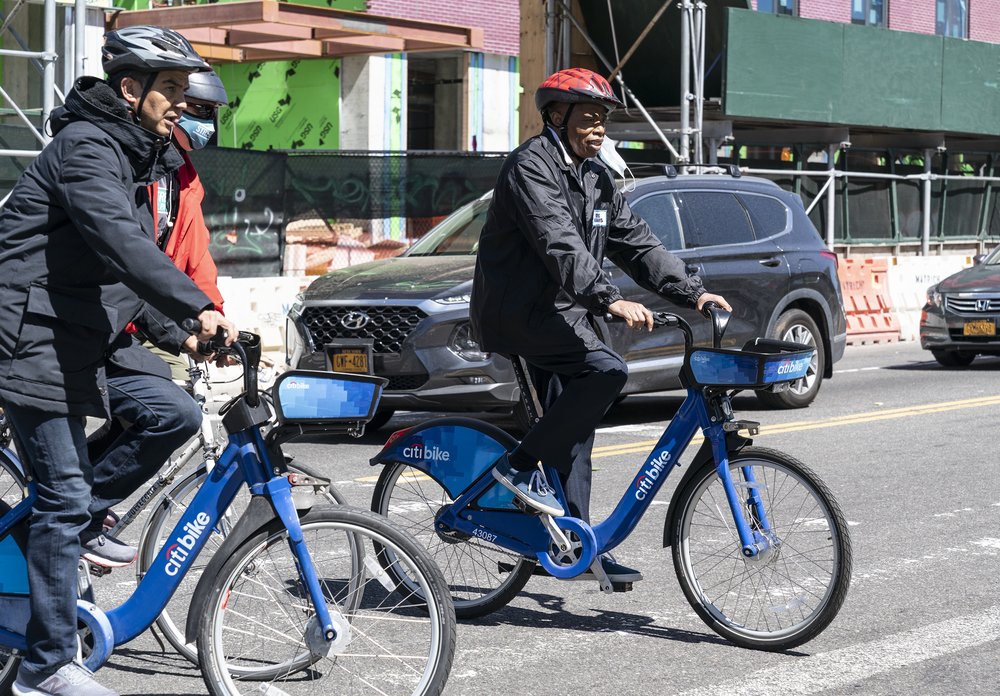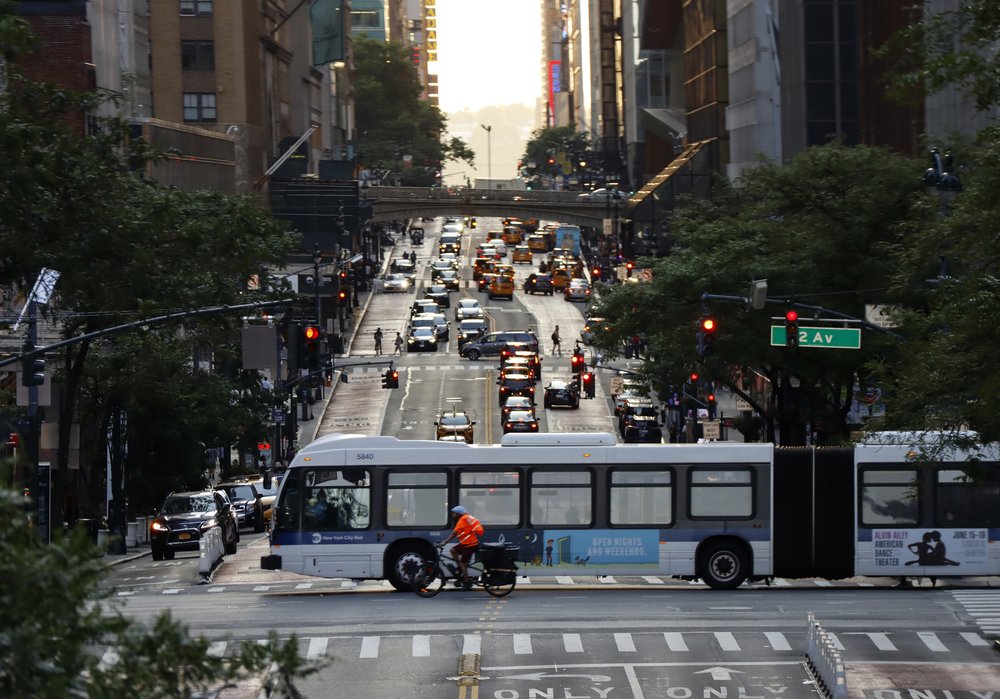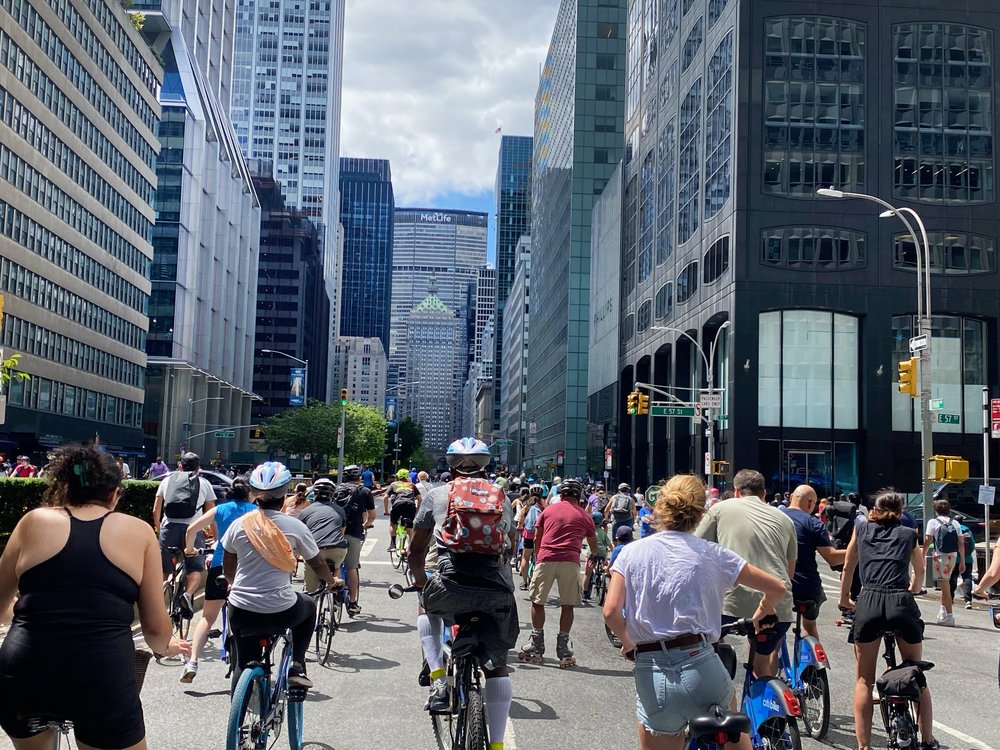Mayor Adams’ pledge to build bike and bus lanes falling short
Sept. 23, 2022, 2:24 p.m.
Mayor Eric Adams set ambitious goals for bus lanes and new protected bike lanes while campaigning for mayor. Both already appear out of reach.

Just nine months after being sworn in, Mayor Eric Adams’ campaign pledge to be the “bike mayor” who installs 300 miles of protected bike lanes and 150 miles of bus lanes in four years is already falling short.
Adams’ administration isn’t close to hitting average yearly milestones for those targets, according to the Mayor’s Management Report released last week, which provides an update on all city agencies’ work.
The report shows there were 32 protected miles installed in fiscal year 2022. But the Department of Transportation won't say how many of those miles were built during former Mayor Bill de Blasio's term, just that it's on track to complete 30 this year. That puts Adams far short of 75 miles of protected bike lanes this year, which is the pace needed to reach his campaign pledge by the end of his term.
Adams has only installed 2 miles of dedicated bus lanes, according to transit advocates who track the city’s work. He would need to install 37.5 miles per year to reach his campaign goal.
Meanwhile, the Transportation under Commissioner Ydanis Rodriguez appears to be struggling to update routine statistics and documents that allow people to identify dangerous intersections and keep track of the city’s progress on its street safety improvements..
Jon Orcutt, an advocate with Bike New York who worked at the DOT under former Mayor Michael Bloomberg, said the DOT’s recent struggles are deterring potential job applicants to the agency.
“It’s repelling people who are the driven, interested, talented cohort that the city needs really badly,” Orcutt said. “It’s an agency that needed to renew its technical chops and get its mojo back, and it’s going in the other direction now.”
It’s not just routine documents that are being neglected.
Eric McClure, executive director of StreetsPac, a political action committee that advocates safe streets, said the agency is behind on a plan to replace 20 miles of plastic barriers that are used in some bike lanes with concrete barriers. Advocates had welcomed the project as a big step to protect cyclists.
“It’s not a quick and easy process, and will probably come up short of what they promised,” McClure said.
The Adams administration initially said the sturdier barriers would be set up in the first 100 days. It then pushed that back to the end of 2023. The DOT told Gothamist it expects to have 10 miles of protective barriers done by the end of this year.
Orcutt credits the agency for one win this year: the two-way protected bike lane announced in May on Schermerhorn Street in Downtown Brooklyn was open to bikers this week, with further improvements coming later this year. He hopes this will be a model for other streets. But he said the biggest challenge will be keeping vehicles out of bike lanes, and he thinks the city still lacks a good template for a bike lane that does that consistently.
“It’s a real free-for-all on the streets and the mayor hasn’t responded to that at all,” Orcutt said, referring to vehicles regularly parking in and blocking the entrances to protected bike lanes.
Bus Goals Gridlock
The Mayor’s Management Report shows there have been 12.9 bus lane miles installed in fiscal year 2022, which ended on June 30. But advocates note nearly 11 of those miles were installed during de Blasio’s term, not in 2022.
“Unfortunately, Mayor Adams isn’t getting things done for bus riders,” said Tabitha Decker, deputy executive director at TransitCenter. “Bus lanes are one of the most effective tools the city has to speed up buses, which are the slowest in the country.”

The Streets Master Plan, a document the City Council passed in the waning days of the de Blasio administration to ensure the DOT meets annual targets, calls for installing 20 miles of bus lanes a year. That’s a smaller number than the mayor’s campaign pledge, but nevertheless a target that still appears to be far greater than what Adams will deliver this year.
“So far, the city has never built 20 miles per year and the clock is ticking to prove they can meet the mark,” said Danny Pearlstein, the policy and communications director with Riders Alliance.
A DOT official said much of its bike and bus lane work is concentrated in the last quarter of the year.
Trouble at the DOT
As Streetsblog reported this week, a chasm of unfilled positions and low morale at the DOT are impacting the agency’s ability to get things done.
An indication of the backroom troubles is the lack of routine updates to DOT documents and data.
For example, the bicycle counts on the DOT’s website haven’t been updated since April. The Open Data portal that tallies bike use at key locations around the city was updated on Thursday, after Gothamist emailed the DOT with questions about stale data.
Vision Zero data on crashes and injuries hasn’t been updated since the end of July. The map currently shows there are 145 traffic fatalities so far in 2022. The DOT told Gothamist that as of Aug. 31 there have now been 174 fatalities.
Other missed deadlines include the Serious Injury Response, Tracking & Analysis Program quarterly report, which is nearly two months late. The document is crucial for watchdogs, journalists, and analysts who track the safety of city streets.

The DOT was more punctual during the de Blasio years in putting out an annual progress report on the Greenwave program, a one-stop shop for information on what is being done to improve city streets. The Adams administration hasn’t released a progress report yet. It also hasn’t put out a Vision Zero review for 2022, which typically comes out in the spring. The DOT did, however, release a report on pedestrians and elderly New Yorkers, which found that seniors make up less than 15% of New York City’s population but over 45% of pedestrian fatalities.
Members of the City Council say they’re getting fed up with the DOT’s pace of work. Councilwoman Julie Won has called dealing with the DOT “like talking to a wall.” She slammed the agency for not making improvements to the Queensboro Bridge’s narrow pedestrian and cyclist path. That project has been pushed back a year.
Others said they’ll keep pushing for improvements where they can, like Councilman Lincoln Restler.
“We've approved $904 million for better bus lanes, more pedestrian space, and protected bike lanes and now we need to pick up the pace on implementation,” Restler wrote in a statement. “Our office is doing everything we can to identify projects across our district and we are committed to provide robust oversight and accountability at the Council to start getting stuff done.”
The DOT didn’t answer questions about missing data and delayed reports. It didn’t say why only 2 miles of bus lanes have been completed so far, but said it’s working toward its goal of 20 by the end of the year. It touted 200 Open Streets locations and a record-breaking 900,000 Citibike rides last week.
“This administration has an ambitious agenda to deliver a safer, healthier, and more sustainable city with a clear focus on providing investment and resources equitably to historically underserved communities,” DOT spokesman Tomas Garita wrote in an email. “Mayor Adams has made a historic $900 million investment into the NYC Streets Plan and we are focused on working toward its aggressive targets.”